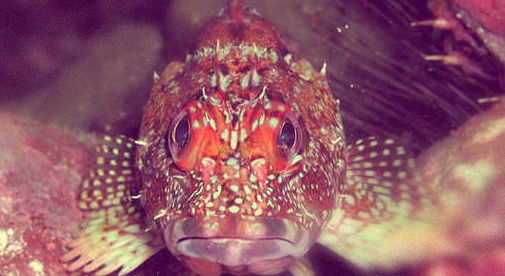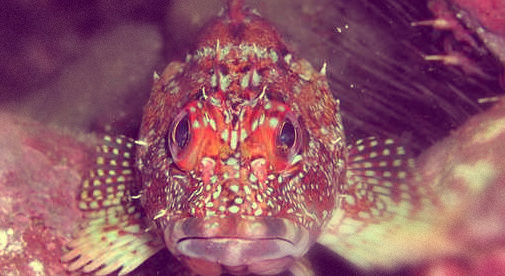A few years ago, I was invited to a designer sushi spot in a wealthy part of San Diego along the coast for an omakase, which essentially means “chef’s choice” in Japanese.
There were no windows in this sushi den. It was all mood lighting, designed to hide the harsh reality that aging really makes us humans look like old cauliflower. Since very few 20-somethings can afford to live in the surrounding neighborhood, the restaurant is frequented by middle-aged women and their retrofitted curvy parts. It’s a crowd full of half-tipsy, half-married people. The employees, however, are all 20-somethings produced from the super-loins of supermodels. They have composure, and appear to be excellent service professionals. But their main purpose is to serve as balls of yarn for the cougar clientele to bat around with their eyes.
The thought of omakase was a little intimidating. As a food writer, chefs seem to think we’ve gone deep into the Vietnamese jungle to find the stream that supplied the world’s first bowl of pho. That we’ve dined on caviar-bedazzled oselots and monkey brains sporting toupées of foie gras. I’m sure that’s a square meal for Anthony Bourdain. But most of us just run around town eating burgers for yet another Top 10 list.
Still, chefs don’t bother giving food writers the prime rib or fries. We’re more likely to get a sous vide cow snout, each nostril filled with deep-fried chicken ovaries.
My friend and I sit at the sushi bar. The only thing between us and the itamae is a glass case of raw seafood. Red fish, yellow fish, orange fish, white fish, purple fish. It reminds me of Amsterdam’s Red Light District—a collection of flesh behind glass, some beautiful, some more suited for fetish.
The chef starts us with gigantic sushi rolls called futomaki. Easy enough. Huge sushi rolls are custom made for Americans. In America, people are less concerned with quality than they are girth. We prefer our food share attributes with top-shelf porn penis.
About halfway through the meal as sake massages our bloodstreams, we notice the chef start to build a really elaborate plate. Garnishes everywhere. Most sushi is served minimally, echoing its origins as Japanese street food. But what he’s designing looks like an Indian wedding or the lobby of a Waikiki Marriott.
He then walks over to the aquarium, which I had thought to be a sadistic interior décor choice—like having cows grazing in the corner of a burger restaurant. He unfolds a step stool, climbs up and grabs a net. He dips it into the water.
The fish look a little concerned. Pick up their pace a bit. But for the most part they keep their composure. Humans wouldn’t be nearly as calm or collected if every few hours, the large hand of god just reached down and scoops up a Volvo full of us. That would make us twitchy.
The chef eventually corners a red rockfish and pulls it out in the net. It doesn’t really struggle. I’m not sure if this is because it’s in shock, or maybe the fish is self-aware. Maybe he realizes he’s a fish, and this is how his fish life goes. It just lays there, a muscular comma in a hammock.
My buddy elbows me and asks me what I think the chef is gonna do with it.
I have no idea. I’m thinking he might ceremoniously present the fish to us, then an apprentice will hurry it back into the kitchen and cook it. I’m not sure why I think they’ll cook it in a sushi restaurant. Eating it raw just doesn’t seem like a very polite option. I mean, unless you find yourself starving in the wilderness, shouldn’t there be a mandatory waiting period between killing an animal and eating it?
I realize I am uncomfortably close to my food’s impending death.
My father didn’t fish. Sure we dangled a few strings over a pier on the resort island of Catalina. But the only fish we caught was a Garibaldi. It was protected by the state because it was orange and adorable. The one we caught seemed fairly cocky about this fact. Just threw itself on the hook to mock us. But no Johnson had ever actually gutted anything, unless you count the time we remodeled the kitchen.
My entire life, the carnivorous process has been comfortably removed from my view. I never saw the slaughter, butchering, transport or packaging. Meat was just a glistening whoopee cushion of flesh under a sheet of cellophane at the grocery store.
And this rockfish… well, it seemed to deserve a little due process. It was a local celebrity. It was an essential part of the interior design. A mascot. Twenty minutes ago, the child of a well-martini’d cougar had been marveling at this fish, joy in his little cougar-child face.
The chef holds the fish tightly in one hand. He’s got a grim, nervous look. That’s when I realize—oh, no. He presses the fish, now struggling a little bit, down onto the cutting board. Then he quickly shanks him in the back of the neck. No other way to say it. When the fish is still alive, it’s not a “knife cut.” It’s a shanking. Same thing that happens when you take the last baked potato in the jail cafeteria.
What happens next is even creepier. He carefully inserts the knife into the fish’s side, and starts to cut.
Oh, jesus.
I’m immediately emotionally scarred. Not a minor, comical scarred. But “Mom, there’s something in Santa’s pants” scarred.
The chef begins to work his knife down the length of the fish. His hands are shaking a little bit. It’s brutal to watch. You see, I’m an animal-loving carnivore. Growing up, I was the weird boy who knocked on our elderly neighbor’s door to ask if I could pet her poodle. I realize our food animals aren’t Thai-massaged until they die of extreme pleasure. I’ve always blindly hoped animals were killed quickly and efficiently.
There is nothing quick about this.
The chef begins to make a series of careful, exacting cuts into the side of the fish’s body. And then—oh Jesus that isn’t…—yes it is. A piece of sashimi dislodges and falls onto the cutting board. The chef cuts a little more. Another piece falls. More cutting, another piece.
The chef carefully places the rockfish down on the plate. He presents it to us without saying a word, and backs away. He’s real solemn about it. Sad. Reverent.
I look down. Half of this fish’s body is still intact. The other half is now perfect pieces of sushi, propped up against the flap of skin where all these pieces of sushi had just been dislodged.
The fish is still alive.
(Note: I’ve since been told that fish move their mouths for a few minutes after they’re dead. So it might have been dead. But at the time, I’m convinced it’s alive. That’s all that matters.)
My friend and I don’t look at each other for a few long seconds. We don’t want to see the horror on each other’s face. Plus, what if the insanity of the situation makes one of us let out a confused chuckle? I’m always afraid at weddings that I’ll just stand up and scream curse words.
I stare at the fish. It stares back. It’s still gasping. My instinct is to take my beer glass and hit it over the head. Finish the job. Or I could just refuse the dish, saying thank you chef but no thank you, serial killer ***hole.
But the chef had shown nothing but reverence. He didn’t fist bump a coworker. It didn’t seem to be a bad fraternity prank, or like flexing in the mirror at the top of the food chain. What if this is a centuries-old Japanese ritual I just don’t know about? Whatever it is, I’m out of my league.
All I can think about the documentary film The Cove. It’s about an area of Japan where dolphins are lured into a bay, harpooned, and used for food. Every American I knew was outraged by the film. What I saw was a bunch of white people who don’t eat dolphins went over to a country where they do eat dolphins. I was wholly unsurprised that the white people were mortified and cried. Frankly, it seemed a little sanctimonious. Just because I love dogs doesn’t mean I’m going to shame someone from a completely different culture for slow-cooking a Chihuahua at 275 degrees. America loves its tasty burger, which freaks Hindus out.
I make a mental note to Google “rock fish tolerance for pain” or “ability to grasp torture” when I get home. Even if I would forever refuse this sort of experience again in my life, I decide to go with it. I am a houseguest, I reason. I’ve been presented a pretty grisly welcome gift. And I’m going to accept it, experience it, see and feel everything it has to teach me.
On instinct, I clasp my hands together, make a minor, awkward head bow toward the fish, and say, “Thank you.”
As a child, I had been taught to say grace before meals. But I’m lucky to have grown up in an environment where eating was a daily, commonplace thing. To be thankful for it seemed like being thankful for air or fingernails.
But this was the first time in my life I’ve ever on a deep, emotional level truly felt grace—a whole-body, overwhelming sense of gratitude.
The fish is… still… alive.
Die, man, die.
It’s not only alive, but it seems to be staring at me. As if to express, Really, guy? You’re going to eat half of me while I fade to black? You’re a real son of a bitch, aren’t ya?
I stick the first piece of sashimi in my mouth. It’s remarkably wet—almost juicy like citrus. The flavors are brilliantly sharp. It’s as if I can literally taste residual electricity that made the muscles twitch and swim. The meat is crunchy, not having gone through rigor mortis needed to become silky smooth.
Between the first and the second bites, the rockfish takes its last gasp. I’m looking into its eyes when this happened. The taste of its own flesh is in my mouth. The sushi chef stands nearby, still quiet. His hands are still shaking. No one would get out of this experience without a little twitch.
Since that night, I’ve talked with sushi chefs about the experience. It’s called izikuri, a Japanese tradition dating back thousands of years. Most cultures aren’t as attached to or squeamish about food animals as Americans. The allure of izikuri is ultimate freshness, and I’m sure a little bit of alpha-species spectacle. It seems even the revered ancient Japanese cultures had a frat boy element. During izikuri, mere seconds pass between death and eating. Or, in cases like ours, they overlap.
There is a point where you’re willing to bend your own ethics out of respect for a cultural tradition. It’s called being a good guest. I never want dinner fed live to me again. But whether it’s an honorable tradition or cruel torture—it changed me on a deep, cellular level. As a carnivore, I was forced to watch what must happen in order for me to eat meat. I actively closed the circle of life. This wasn’t an abstract documentary. This wasn’t a PBS special. This was my dinner. I’ve never been so humbled.
My friend and I ate the rest of the sushi. When done, the chef removed the other half of the rockfish, sent it to the back, and it and returned it roasted whole. We felt it our duty not to waste one bit of the life-sustaining protein we’ve just helped kill. We eat the cheeks, the eyeballs, the bits.
We get drunk. Dead drunk.
Ideally, I wouldn’t have to eat an animal as it dies to learn this lesson. Ideally, I could intellectually fill in the gaps. But you can intellectualize skydiving, and then you can jump out of a plane at 10,000 feet and feel the adrenaline rip through your insides like desert lightning.
That meal is tattooed on my memory. I think about it nearly every time I eat.
I’m still a carnivore. If I become a better person or if all of my taste buds die in a fire, I might become vegetarian. But I have tried to waste as little meat as someone in my profession can. But once I saw life become food on my plate, I wasted even less.
From that day forward I’ve said grace at every meal. That rockfish altered me for good.
It took the anonymity out of the carnivore process. It reconnected my emotions into my food. I don’t like to think—I know—I’m a better human for it.

Look Your Food in the Eye















